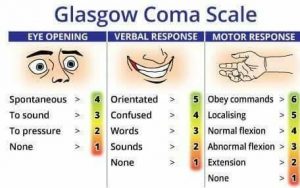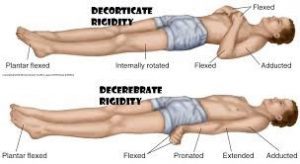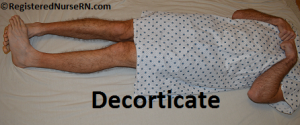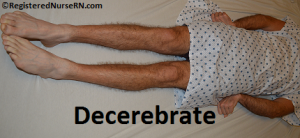 …………………..
…………………..
The Glasgow Coma Scale, abbreviated GCS, is a brain injury severity scale that assesses the level of impairment of consciousness in brain injured patients. It is the most common tool used by clinicians to measure improvement or deterioration in the emergent and acute stages of brain injury or brain lesions. The scale measures the level of eye opening, verbal response, and motor response and assigns a score to each level, obtaining a total score that indicates the level of consciousness.
| Response | Scale | Score |
| Eye Opening Response (E) | Spontaneous To sound To pressure None |
4 3 2 1 |
| Best Verbal Response (V) | Oriented Confused conversation Words (inappropriate) Sounds (not comprehensible) None |
5 4 3 2 1 |
| Best Motor Response (M) | Obey commands Localize pain Normal flexion Abnormal flexion Extension None |
6 5 4 3 2 1 |
| Total Score | Minimum score of 1 in each subtest = 3 Maximum score = 15 E + V + M = Total score |
Score <8 = Severe injury (Coma) 9-12 = Moderate injury 13-15 = Mild or no injury |
Occupational therapy treatment is graded based on the score on the GCS.
Score <8, severe injury– treatment begins with passive range of motion, sensory stimulation activities.
Score 9-12, moderate injury– treatment begins with assisted motor activities, hand over hand ADL tasks, simple cognitive tasks, visual and verbal cues for each step of a task.
Score 13-15, mild injury – treatment begins with active motor activities, demonstration and verbal cues for ADL tasks, higher level cognitive tasks, set-up and periodic cues during tasks.
The Motor Response component of the GCS.

When an individual scores below four points on motor response, the scale identifies a decorticate or decerebrate posture response.
Posturing is frequently observed in patients who are comatose following a traumatic brain injury. Decorticate and Decerebrate posturing refers to primitive, stereotyped motor responses exhibited by patients with severe brain injury. These are reflex motor movements as opposed to functional motor actions.

Decorticate Posturing/Rigidity – the patient postures with the arms adducted and flexed, the fists clenched, the legs extended and internally rotated, and the feet turned inward. Decorticate rigidity in response to pain results in a Glasgow Coma Scale M rating of 3.
Decerebrate Posturing/Rigidity – the patient postures with head and neck extended, arms and legs extended, arms and legs internally rotated, teeth clenched. Decerebrate rigidity in response to pain results in a Glasgow Coma Scale M rating of 2.
Mnemonic for DECORTICATE POSTURING: Remember the letters COR in the word decorticate for the word “core”. The patient will bring their ARMS to the core of the body (middle).

Mnemonic for DECEREBRATE POSTURING: Look at all the E’s in the word. There are a lot of them, so remember the word EXTENDED.

Decorticate vs Decerebrate Posturing
A decorticate posture is indicative of a lesion in the cerebral hemispheres or disruption of the corticospinal tracts. Although it is serious, it is usually not as serious a decerebrate posture. The posturing may occur on one or both sides of the body.
A decerebrate posture indicates lesions of the upper part of the brainstem or severe bilateral lesions of the cerebrum. A decerebrate posture can occur on one side, on both sides, or in just the arms. It may alternate with a decorticate posture. A person can also have decorticate posture on one side of the body and decerebrate posture on the other side.
Opisthotonos (a severe muscle spasm of the neck and back) may occur in severe cases of decerebrate posture.
References:
https://www.rainbowrehab.com/RainbowVisions/article_downloads/articles/Art-TECH-GComaScale.pdf
https://link.springer.com/referenceworkentry/10.1007%2F978-3-642-00418-6_395
https://medical-dictionary.thefreedictionary.com/d